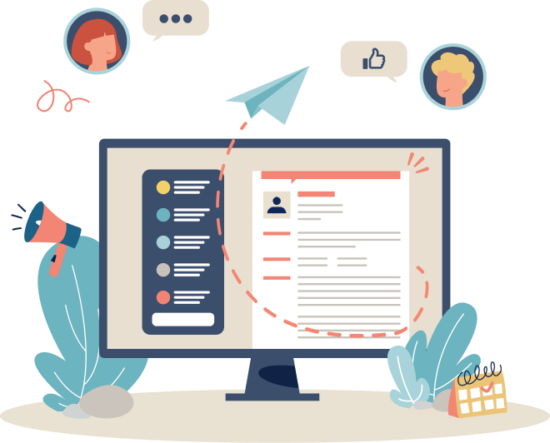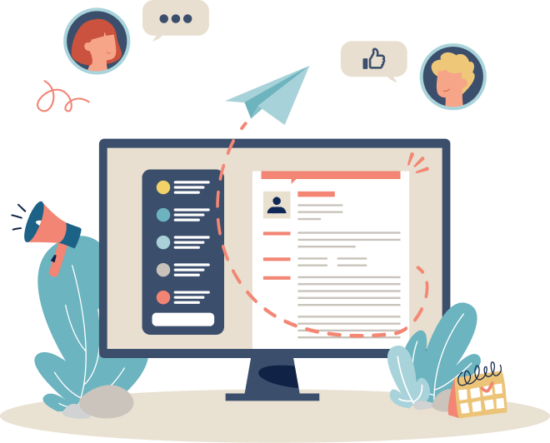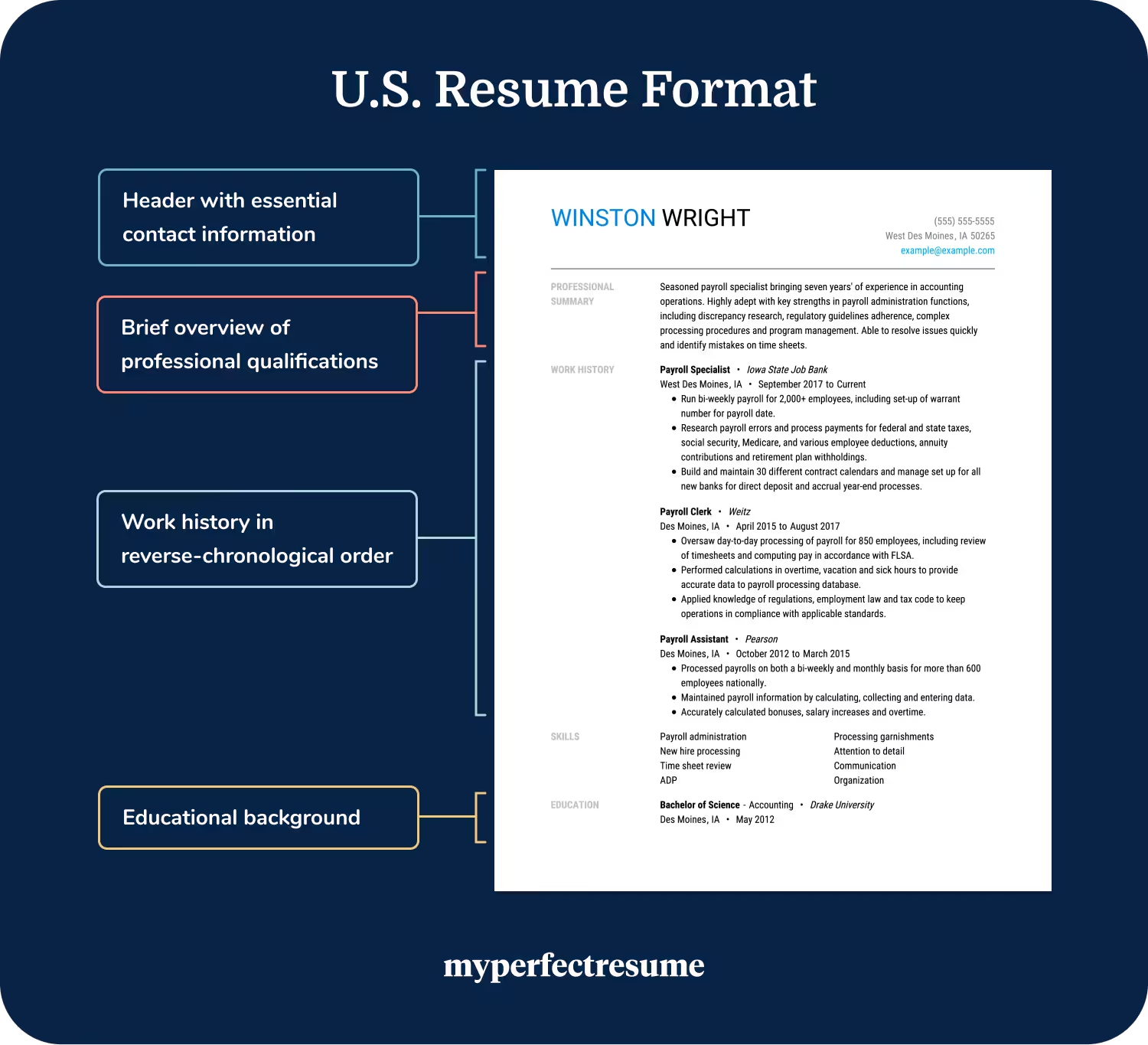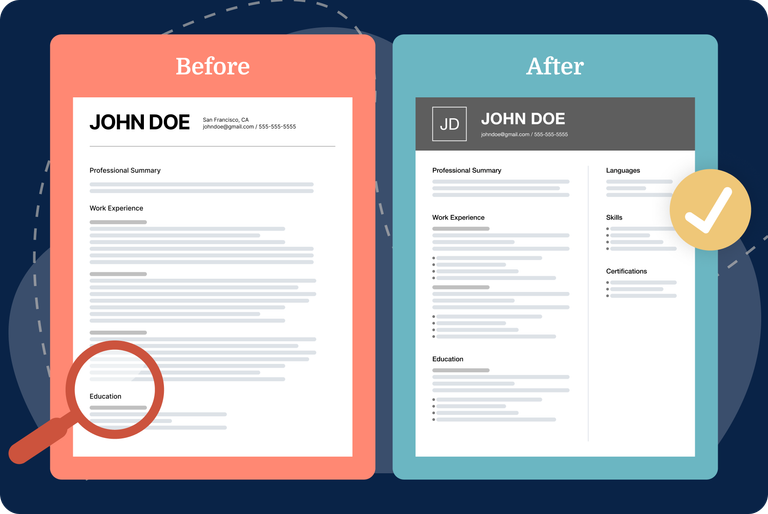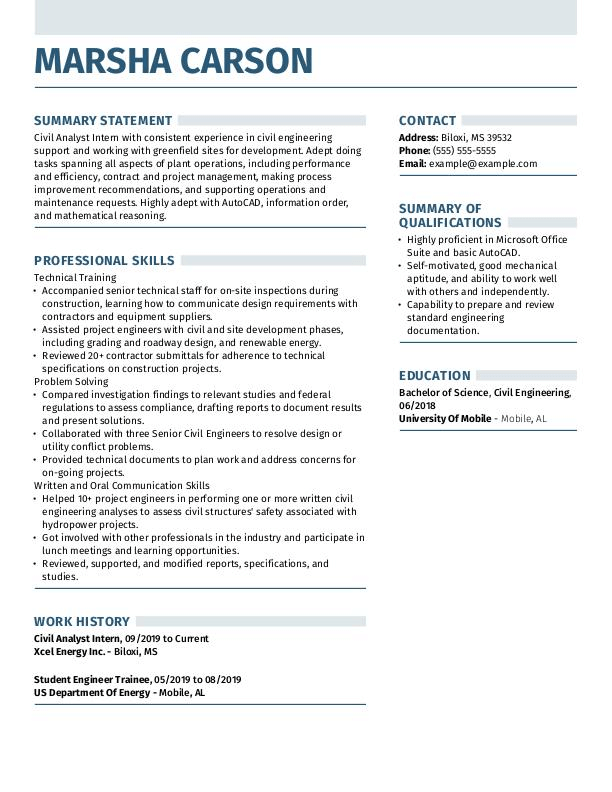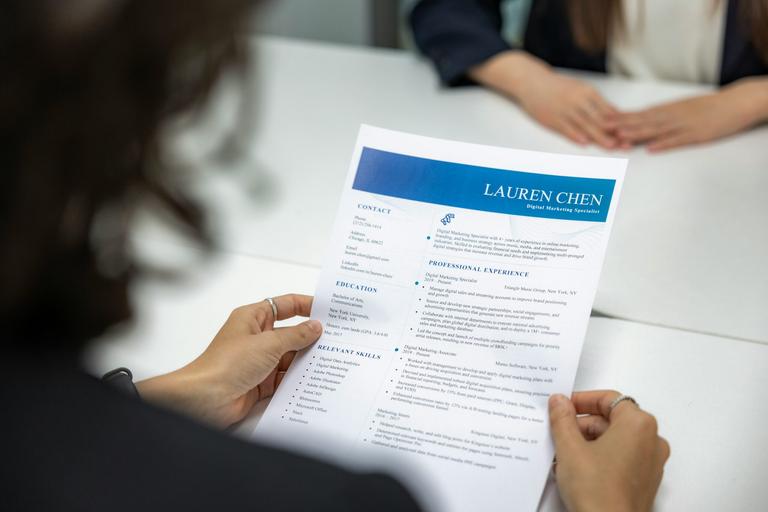What Is a Resume? (Definition, Purpose & Examples)

Our customers have been hired at: *Foot Note
It's no secret that a resume is a crucial part of a job application. It showcases your brand and career growth and is a reference point for job interviews.
So, what exactly is a resume, and why is it so important? Read on to get all your answers.
Jump to the following section:
What Is a Resume?
Merriam-Webster defines the traditional resume as "a short account of one's career and qualifications."
A resume is the standard document a job seeker includes in a job application. It concisely overviews your education, work experience, professional skills, and other qualifications, such as certifications and awards, that demonstrate to employers why you're suitable for the role.
What is the purpose of a resume?
Many job seekers assume a resume must detail their entire career, but that's not the case. Resumes are skimmable and highly tailored documents that quickly highlight your most relevant qualifications for the role you’re applying to, making them a crucial part of any job application.
The goal of a resume is to convince employers you're a qualified candidate who deserves to advance to the next phase of the hiring process and, hopefully, get hired.
Some careers, like those in academia and government, require job seekers to share their entire work history. In those cases, a CV is more appropriate. Learn what is the difference between a CV and a resume to see which one works for you.
Resume Example
Teacher resume
This sample teacher’s resume can help you visualize how a classic resume should look with standard sections and a simple template:
Customer service representative resume
This customer service representative resume uses a combination format to provide a balanced view of the job seeker’s experience and skills.
Our resume examples library has hundreds of sample resumes across industries, so you can see how other job seekers highlight their qualifications and start writing your own.
Types of Resumes
There is no one-size-fits-all resume. Different resume types can emphasize different job qualifications, depending on your background, career goals, and the job you are applying for.
Customize your resume for each application to effectively highlight your most relevant information and increase your chances of getting an interview.
When deciding what to include on your resume and how to organize its sections, consider the three traditional types of resumes you can choose from — also known as resume formats:
Chronological resume
The chronological resume format is the most widely used. It emphasizes your work experience, placing it at the top of your resume and starting with your most recent position. This format works best for professionals with a consistent work history who want to highlight their career progression.

Functional resume
The functional resume focuses on your skills and qualifications rather than your work history. It highlights your abilities and achievements, organized by skill categories. Job seekers with minimal or no experience benefit from this resume format.

Combination resume
As the name suggests, the combination resume format combines elements of chronological and functional resumes. It provides a balanced view of your skills and work experience, allowing you to showcase your qualifications while providing a chronological overview of your employment history. This format is recommended for mid-level professionals looking to advance their careers.

Whether you opt for a chronological, functional, or combination format, a resume template will help you structure your resume sections efficiently to spotlight your strengths and ensure recruiters see your top credentials.
What to Put on a Resume
Deciding what to include on your resume will vary depending on your career level, industry, and job goals. However, there are five essential sections every resume must have:
Contact information
Your resume header should always include:
- Full name.
- Email.
- Phone number.
- Professional online profile, if applicable.
Resume summary or objective statement
A resume summary or objective statement introduces you to employers by highlighting your most impressive skills and achievements to quickly grab their attention.
Use a summary if you're an experienced candidate and an objective statement if you're a recent graduate or career changer.
Pro-tip:
Our AI Resume Summary Generator provides industry-specific content suggestions to help you start writing your introduction and convince employers you're the right fit for the role.
Work experience
The work history section of your resume details your relevant past roles. Organize your jobs in reverse-chronological order and include company names and employment dates.
Detail your job duties using bullet points and, if applicable, mention quantifiable achievements that convey your initiative and innovation.
Skills
Your skills section should list six to eight soft and hard skills demonstrating your ability to perform the job. Read the job description carefully to identify key skills the employer seeks and determine which ones best describe your professional abilities.
Struggling to find the right skills for your resume? Our AI Resume Skills Generator instantly delivers a tailored skills list you can copy and customize to fit your needs.
Education
Write the school name, degree, and location in your education section. Always start with your highest degree. You can also add relevant coursework if you're a recent graduate looking to explain further how you can fit the role.
Optional sections
In addition to the standard sections, there are optional sections you can include to explain your credentials further and make your resume stand out:
- Certifications and licenses: Ideal for fields requiring specific credentials (e.g., IT, healthcare, project management, teaching).
- Projects: Showcases hands-on experience, especially for students, freelancers, or career changers.
- Volunteer experience: Highlights transferable skills and commitment, especially if paid experience is limited.
- Awards and honors: Demonstrates achievements and recognition in academic or professional settings.
- Publications: Useful for writers, researchers, or academics.
- Professional associations and memberships: Shows industry involvement and networking efforts.
- Languages: Useful for global roles or customer-facing positions.
Our complete guide on writing a resume has all the information, examples, and expert tips you need to create a polished resume that wins interviews.
Key Takeaways
- A resume is a concise document that outlines your professional qualifications. Resumes are crucial because they tell employers what you can do for them, showcase your brand, and serve as a timeline of your professional success.
- All resumes must be customized for each new job you apply to.
- There are three standard resume formats: chronological, functional and combination. Each one displays your qualifications differently, based on your experience and goals.
- Resumes must include the five standard sections: contact details, introduction, work experience, skills, and education. Including other sections is optional.
What Is a resume? FAQ
Is a resume the same as a CV?
While a resume and a curriculum vitae (CV) share similarities, they have distinct differences. A resume is typically shorter, usually limited to one or two pages focusing on your relevant skills and experiences for a specific job.
On the other hand, a CV is more comprehensive, providing a detailed overview of an individual’s academic and professional background, including publications, research, and presentations.
Knowing when to use a resume vs a CV depends on the role you’re applying for. In the U.S., academic, legal, medical, and scientific roles regularly require a comprehensive CV while most other jobs require a resume.
What is an ATS resume?
An ATS, or applicant tracking system, refers to software designed to scan resumes for keywords and filter out ones that don’t include the credentials recruiters are looking for.
Many companies and organizations use ATS software to manage and streamline recruitment processes. When you submit your resume online or through an application portal, it is often first reviewed by an ATS before being seen by a human recruiter.
You can use our ATS resume scanner to analyze your resume for common errors and receive personalized feedback to improve your score.
By optimizing your resume for ATS, you increase the chances of your resume being selected for further review by human recruiters.
How do you write an ATS resume?
To create an ATS-friendly resume, it is important to consider the following:
- Formatting: Use a simple and clean format with standard fonts and avoid using images, graphics, or complex formatting. Define clear sections and use bullet points to help the ATS easily scan your information.
- Keywords: Tailor your resume to include relevant keywords and phrases commonly used in the job description. Integrating keywords into your resume helps the ATS identify your skills and qualifications and rank your resume higher.
- File type: Save your resume in a compatible format, such as a Word document (.doc or .docx) or a PDF. Avoid using file formats that may not be compatible with the ATS, such as JPEG, SVG, or any file format listed as incompatible when uploading your resume.
- Section headings: Use standard section headings such as “Education,” “Work Experience,” “Skills,” and “Achievements” to help the ATS categorize and analyze your information.
- Spell out acronyms: While you may be familiar with industry-specific acronyms, the ATS may not recognize them. Spell out acronyms to ensure the ATS can properly understand and categorize your skills and qualifications.
What is a cover letter?
A cover letter is a formal document that accompanies your resume when applying for a job or internship. It allows you to introduce yourself to the employer and expand on specific achievements or experiences in your resume, providing more depth and insight into your skills and suitability for the role.
The purpose of a cover letter is to complement your resume by providing additional context and showcasing your written communication skills.
When writing a cover letter, you typically address the hiring manager or recruiter, briefly explaining why you are interested in the position and the company, and highlighting the key qualifications and experiences that make you a strong candidate.
How do you customize a resume?
Customization is key to making your resume stand out and demonstrate your suitability for a particular job. By aligning your resume with the position’s requirements, you increase your chances of getting noticed by employers and securing an interview.
Customizing a resume involves tailoring it to a specific job or industry to highlight your relevant skills, experiences, and qualifications.
Here are some steps to help you customize your resume effectively:
- Review the job description: Carefully read the job description and make note of the key skills, qualifications, and requirements mentioned. This will help you understand what the employer is looking for in a candidate.
- Identify relevant skills and experiences: Match your own skills, experiences, and achievements to the requirements of the job. Focus on highlighting those that directly relate to the position you are applying for.
- Use keywords: Incorporate relevant keywords from the job description throughout your resume. This can help your resume pass through ATS and catch the attention of hiring managers.
How should I format my resume?
When formatting a resume, it is important to maintain a clean and professional appearance. Use a clear and legible font, such as Arial or Times New Roman, and organize the content into sections with appropriate headings. Utilize bullet points to highlight key information and ensure consistency in formatting throughout the document. Additionally, decide which resume format you will use to organize your qualifications, depending on your specific circumstances and the job requirements.
What is the best resume format?
When choosing a resume format, consider the job requirements, your level of experience, and industry norms. Additionally, ensure that your resume is well-organized, easy to read, and tailored to the job you are applying for.
The best resume format ultimately depends on your specific circumstances and the industry or job you are applying for.
There are three common resume formats to consider:
- Chronological: This is the best format if you have a consistent work history and want to highlight career progression.
- Functional: This format is best if you have limited work experience, are changing careers, or want to emphasize specific skills relevant to the job.
- Combination: This format is best if you have a diverse skill set and want to emphasize your experience and abilities.
Why is a well-crafted resume important?
A well-crafted resume is crucial because it is your first impression to potential employers. It allows you to effectively showcase your qualifications, skills, and experiences, increasing your chances of being invited for an interview.
A strong resume demonstrates your professionalism, attention to detail, and ability to effectively communicate your value to the employer.
How do you write a resume with no experience?
Writing a resume with no experience can feel challenging, but it’s still possible to create a compelling document that highlights exactly what you bring to a job. Even without formal work experience, you have skills, enthusiasm, and potential you can showcase on your resume.
Focus on transferable skills, relevant coursework or projects, and any other experiences that demonstrate your capabilities.
Our customers have been hired at:*Foot Note
